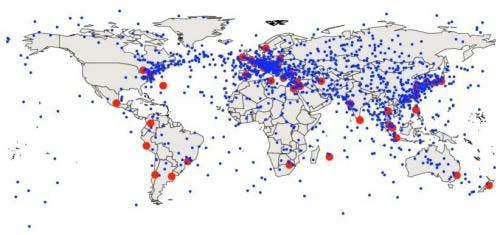
In a world where the king words are ‘buy low, sell high’, speed is of upmost importance. Stock trading has become more and more reliant on modern ways of transmitting and processing information, and in this process, fiber optic plays a crucial role. While fiber optic does work at 90 percent the speed of light, companies can still exploit physics and position themselves faster in locations capable of more competitive speeds and transactions, at least according to Dr. Alexander Wissner-Gross.
He first published some research on the matter in 2010, and now he’s come back with more conclusive data, and with a list of determined locations which are the optimal sites to compete with the current locations of financial markets. With the basic idea that the shortest distance between two points is a line, he set out to find points which are as close to the center of the line as possible.
For example, if you were trading in New York and in Paris, the best location for you would be somewhere in the middle of the Atlantic Ocean; however, as good as this idea is in theory, there aren’t too many companies willing to build floating offices, so Dr. Wissner-Gross started approximating points close to the center of the line, but where offices can be built. Using the above example, the best place would probably be Nova Scotia.
This probably doesn’t seem like a big deal; but with the competition growing more fierce every day, and with stock offices being less and less dependant on the agitation of urban areas, we might just see a surge in offices appearing in the most unlikely areas, and if placed right, this could just give companies the necessary edge to raise their shoulders above the competition.





